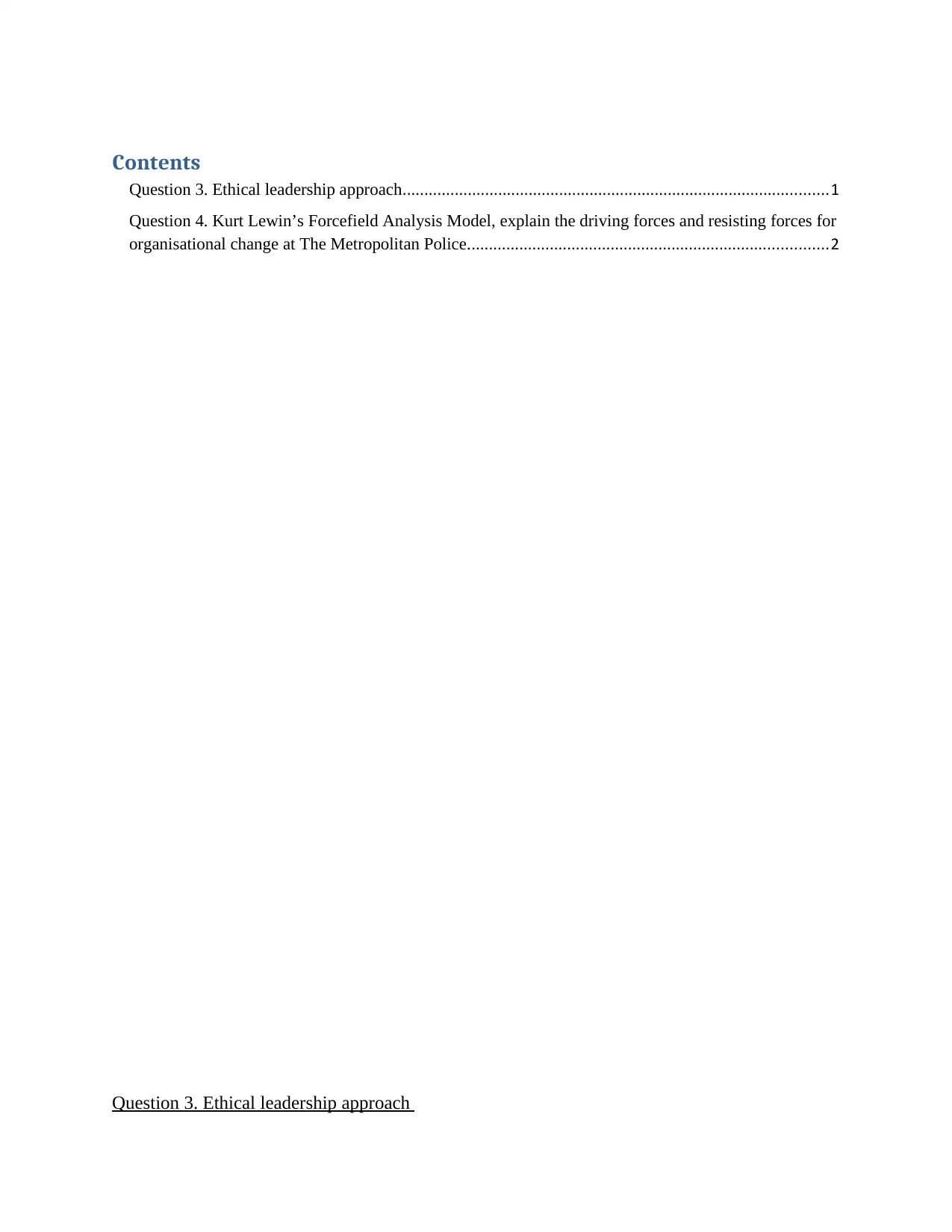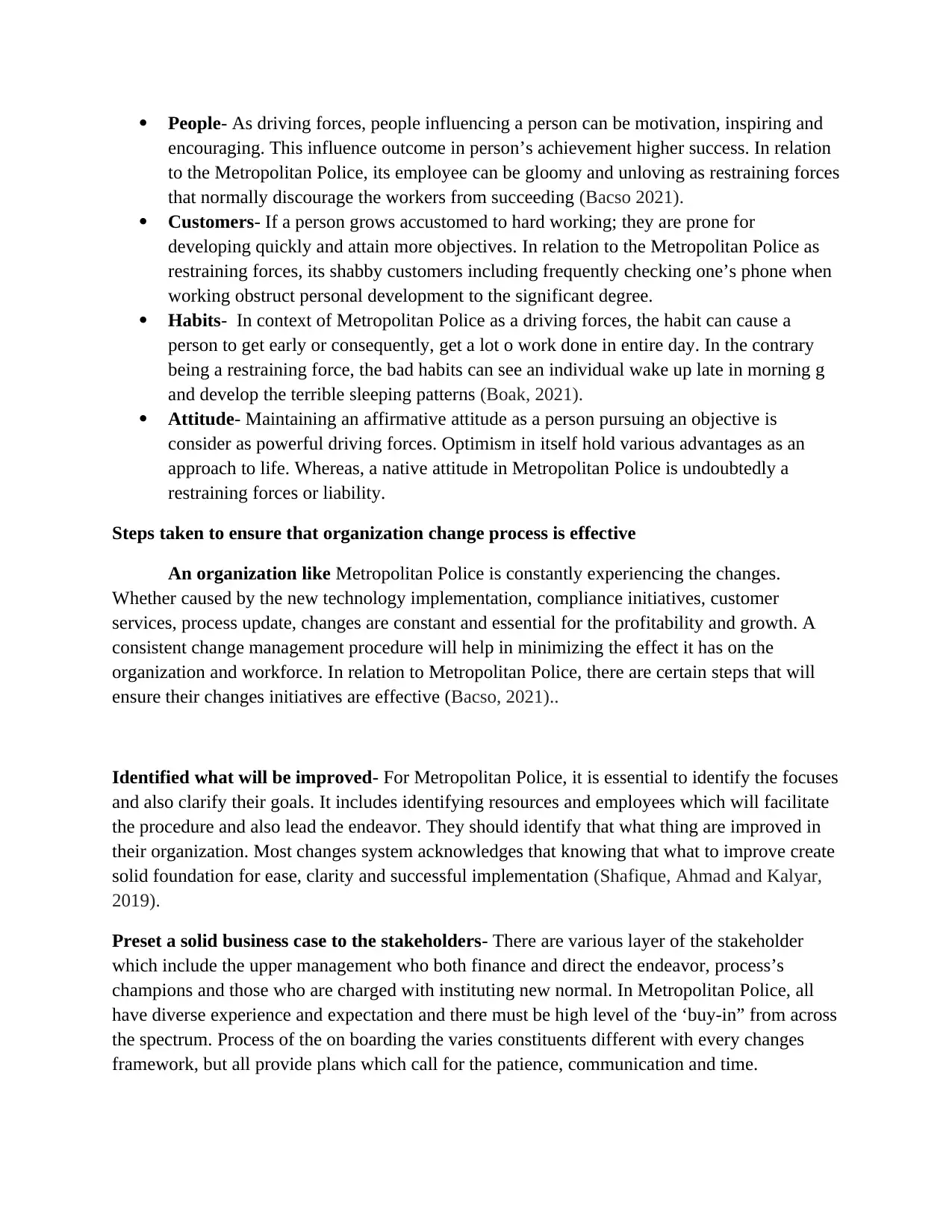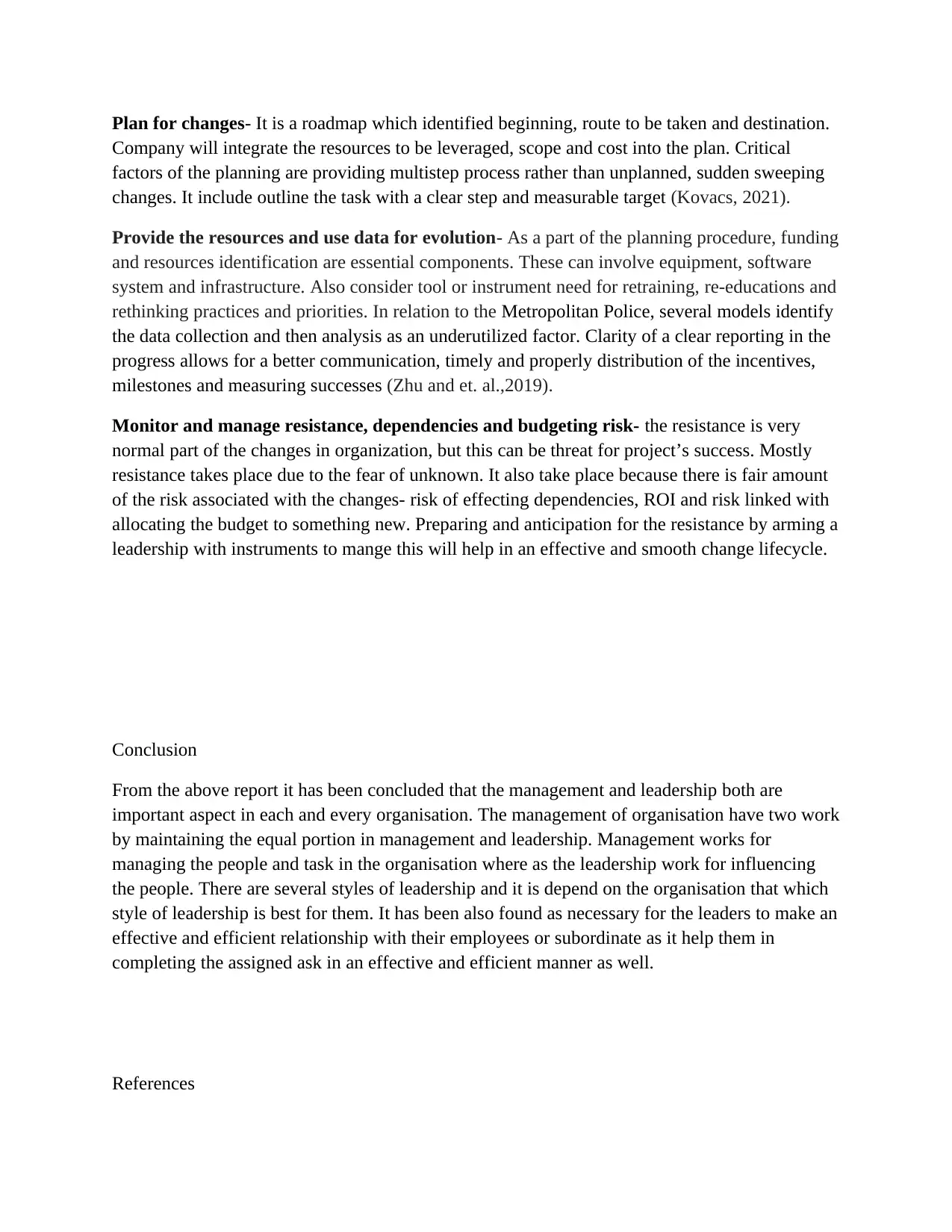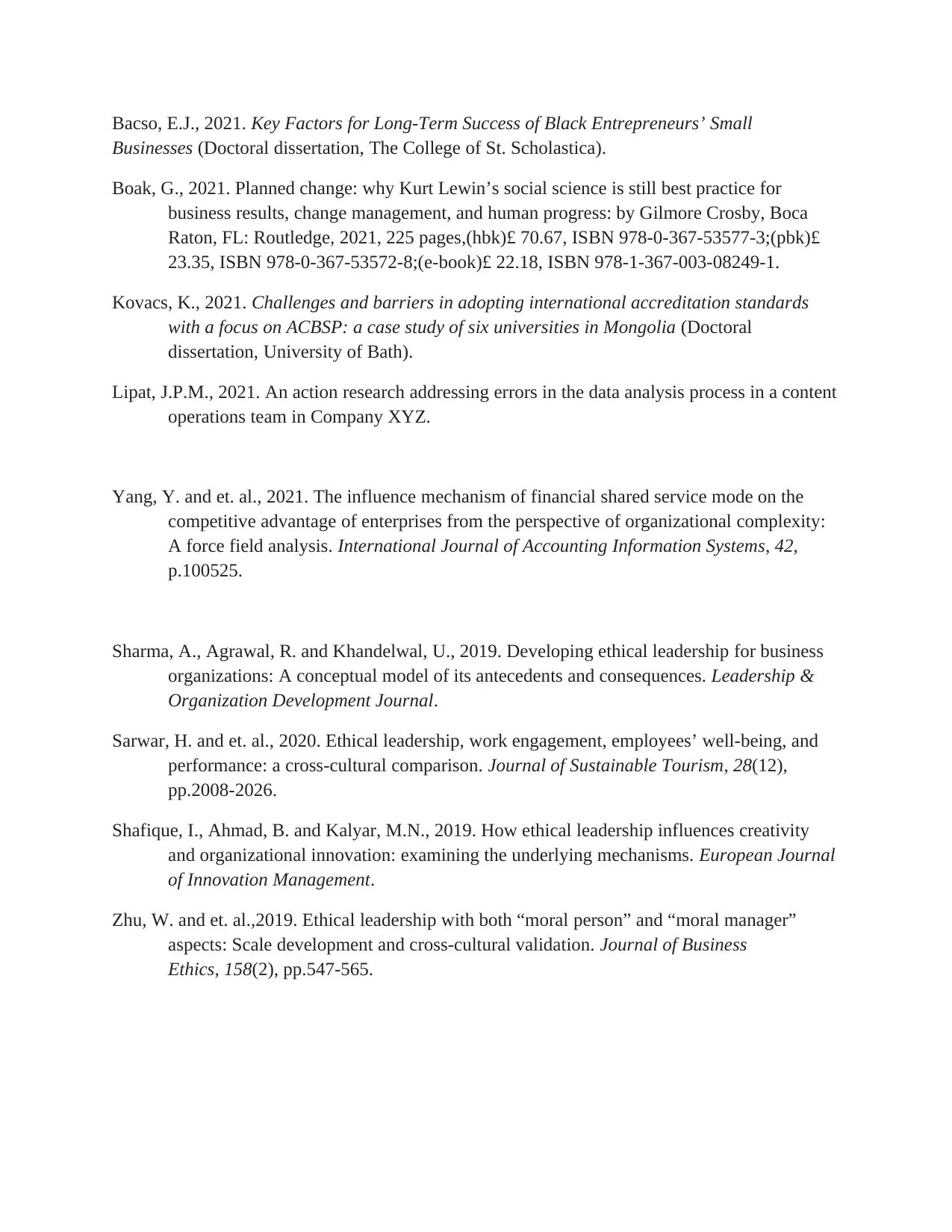Ethical Leadership Approach & Forcefield Analysis in Organisation
VerifiedAdded on 2023/06/09
|6
|2227
|53
Report
AI Summary
This report provides an analysis of ethical leadership approaches and Kurt Lewin's Forcefield Analysis Model in the context of the Metropolitan Police. It defines ethical leadership as influencing others through morals, trust, and accountability, and discusses how ethical leaders can improve employee well-being, customer relationships, and organizational reputation. The report also examines Kurt Lewin's Forcefield Analysis, identifying driving and restraining forces for organizational change within the Metropolitan Police, such as the influence of people, customer interactions, habits, and attitudes. Furthermore, it outlines steps to ensure effective organizational change, including identifying areas for improvement, presenting a business case to stakeholders, planning for changes, providing resources, and managing resistance. The conclusion emphasizes the importance of both management and leadership, and the need for leaders to build strong relationships with their employees. The document is available on Desklib, a platform that provides all the necessary AI-based study tools for students.

Contents
Question 3. Ethical leadership approach..................................................................................................1
Question 4. Kurt Lewin’s Forcefield Analysis Model, explain the driving forces and resisting forces for
organisational change at The Metropolitan Police...................................................................................2
Question 3. Ethical leadership approach
Question 3. Ethical leadership approach..................................................................................................1
Question 4. Kurt Lewin’s Forcefield Analysis Model, explain the driving forces and resisting forces for
organisational change at The Metropolitan Police...................................................................................2
Question 3. Ethical leadership approach
Paraphrase This Document
Need a fresh take? Get an instant paraphrase of this document with our AI Paraphraser

Ethical approach of leadership is defined as the art of influencing the other people or
subordinates and provides several new guidelines to them, so that they can effectively make the
decisions in the ethical form such as the morals, trust, accountability, mutual respect, fairness,
ethics, accountability, honesty and many more. If the Metropolitan Police will hire the new heads
who will going to adopt ethical leadership approach, it result in developing the equal strategies
for each and every employee working in the business organisation. The main objective of
bringing or hiring new leader in the Metropolitan Police is to treat all the employees equally and
not make any difference on the basis of ethics. It has been analysed that the leaders of a business
organisation directly effect the employees and they also help the organisation to behave in more
ethical manner. Through providing the several directions to the ethical behaviour, all the
subordinates and employees in the organisation will work in an effective and efficient manner. In
simple words, it can be said that the ethical leaders can influence the subordinates in more
appropriate and positive manner. Through hiring ethical leader in the respective business
organisation, it will bring the credibility and enhance the reputation of respective business
organisation in the market. The unethical behaviour of leaders in The Metropolitan Police result
in the automatic damage in the brand image of organisation. Below mentioned are teh several
ways in which the ethical behaviour of leaders can affect the organisation:
Increase sense of belonging: When corporate and individual values are aligned and
ethical principles are adopted, the general well-being of all is increased. This creates a
positive atmosphere that strengthens and encourages ethical behavior, and creates a
positive loop that everyone feels at ease and with the right attitude to do their best
(Sharma, Agrawal, and Khandelwal, 2019).
Improved relationships with customers: Customers will recognize ethical leadership and
cultural values and will feel that they have made a good decision to work with your
company when they witness it. This encourages them to continue to do business with in
the increasing their reputation as one of the fairest players in the market.
Respect from society and communities: Organizations led by ethical leaders are
respected and valued because they set an example for others. These are the types of
companies where people want to work, do business, and emulate in their own business.
Support in time of crises: The world is changing rapidly, and businesses face numerous
challenges. People, on the other hand, want ethical leaders and the companies for which
they work to thrive. Having a leader who acts ethically, with kindness and respect, can be
the ticket to overcoming adversity (Sarwar and et. al., 2020).
subordinates and provides several new guidelines to them, so that they can effectively make the
decisions in the ethical form such as the morals, trust, accountability, mutual respect, fairness,
ethics, accountability, honesty and many more. If the Metropolitan Police will hire the new heads
who will going to adopt ethical leadership approach, it result in developing the equal strategies
for each and every employee working in the business organisation. The main objective of
bringing or hiring new leader in the Metropolitan Police is to treat all the employees equally and
not make any difference on the basis of ethics. It has been analysed that the leaders of a business
organisation directly effect the employees and they also help the organisation to behave in more
ethical manner. Through providing the several directions to the ethical behaviour, all the
subordinates and employees in the organisation will work in an effective and efficient manner. In
simple words, it can be said that the ethical leaders can influence the subordinates in more
appropriate and positive manner. Through hiring ethical leader in the respective business
organisation, it will bring the credibility and enhance the reputation of respective business
organisation in the market. The unethical behaviour of leaders in The Metropolitan Police result
in the automatic damage in the brand image of organisation. Below mentioned are teh several
ways in which the ethical behaviour of leaders can affect the organisation:
Increase sense of belonging: When corporate and individual values are aligned and
ethical principles are adopted, the general well-being of all is increased. This creates a
positive atmosphere that strengthens and encourages ethical behavior, and creates a
positive loop that everyone feels at ease and with the right attitude to do their best
(Sharma, Agrawal, and Khandelwal, 2019).
Improved relationships with customers: Customers will recognize ethical leadership and
cultural values and will feel that they have made a good decision to work with your
company when they witness it. This encourages them to continue to do business with in
the increasing their reputation as one of the fairest players in the market.
Respect from society and communities: Organizations led by ethical leaders are
respected and valued because they set an example for others. These are the types of
companies where people want to work, do business, and emulate in their own business.
Support in time of crises: The world is changing rapidly, and businesses face numerous
challenges. People, on the other hand, want ethical leaders and the companies for which
they work to thrive. Having a leader who acts ethically, with kindness and respect, can be
the ticket to overcoming adversity (Sarwar and et. al., 2020).

There are several ethical values Managers and Leaders need to have to be successful while
adopting Ethical approach of leadership. Some of them are given below:
Honest: Honesty makes ethical leaders worthy of the trust that others place in them. This means
that leaders are committed to presenting facts, dealing fairly with their competitors, and
communicating honestly with others.
Justice: Being fair means treating everyone equally, providing opportunities without favor, and
condemning improper behavior or manipulation, or other behavior that may harm someone.
Means.
Respect: Ethical leaders respect others around them, regardless of their position or distinguishing
traits. This means that they listen to all stakeholders and promote inclusion and diversity of
values (Boak, G., 2021).
Dignity: Honesty is shown when values, words, and actions are consistent and consistent.
Speaking is not enough. The organisation have to walk the way to show the integrity.
Responsibility:. Responsibility means accepting responsibility, accepting the power and
obligations that come with it, always responding quickly, and confronting difficult situations.
Transparency: Above all, transparency is about communicating with everyone involved. It means
having an open dialogue, accepting feedback, and disclosing the information that others need to
do their jobs.
All the above are the manners which bring the Metropolitan Police towards the success as it add
the effectiveness and efficiency in the performance and operations of leaders.
Question 4. Kurt Lewin’s Forcefield Analysis Model, explain the driving forces and resisting
forces for organisational change at The Metropolitan Police.
This analysis defined and suggest that all the two forces signify the equilibrium between
them that pulls in reverse directions. For instance, this analysis stats that why the pan can be
place on the table top without it falling through the table. In General words the analysis stats that
this is conducted when there is need or knowledge of understanding.
Restraining gad n driving forces- two primary components of the Lewin force filed analysis are
restraining forces and driving forces. These two elements determine a being’s statue of the
equilibrium. The driving forces are constructive, optimistic and economic elements which lift an
object. In relation to the Metropolitan Police, there certain restraining and driving forces which
are mentioned below:
adopting Ethical approach of leadership. Some of them are given below:
Honest: Honesty makes ethical leaders worthy of the trust that others place in them. This means
that leaders are committed to presenting facts, dealing fairly with their competitors, and
communicating honestly with others.
Justice: Being fair means treating everyone equally, providing opportunities without favor, and
condemning improper behavior or manipulation, or other behavior that may harm someone.
Means.
Respect: Ethical leaders respect others around them, regardless of their position or distinguishing
traits. This means that they listen to all stakeholders and promote inclusion and diversity of
values (Boak, G., 2021).
Dignity: Honesty is shown when values, words, and actions are consistent and consistent.
Speaking is not enough. The organisation have to walk the way to show the integrity.
Responsibility:. Responsibility means accepting responsibility, accepting the power and
obligations that come with it, always responding quickly, and confronting difficult situations.
Transparency: Above all, transparency is about communicating with everyone involved. It means
having an open dialogue, accepting feedback, and disclosing the information that others need to
do their jobs.
All the above are the manners which bring the Metropolitan Police towards the success as it add
the effectiveness and efficiency in the performance and operations of leaders.
Question 4. Kurt Lewin’s Forcefield Analysis Model, explain the driving forces and resisting
forces for organisational change at The Metropolitan Police.
This analysis defined and suggest that all the two forces signify the equilibrium between
them that pulls in reverse directions. For instance, this analysis stats that why the pan can be
place on the table top without it falling through the table. In General words the analysis stats that
this is conducted when there is need or knowledge of understanding.
Restraining gad n driving forces- two primary components of the Lewin force filed analysis are
restraining forces and driving forces. These two elements determine a being’s statue of the
equilibrium. The driving forces are constructive, optimistic and economic elements which lift an
object. In relation to the Metropolitan Police, there certain restraining and driving forces which
are mentioned below:
⊘ This is a preview!⊘
Do you want full access?
Subscribe today to unlock all pages.

Trusted by 1+ million students worldwide

People- As driving forces, people influencing a person can be motivation, inspiring and
encouraging. This influence outcome in person’s achievement higher success. In relation
to the Metropolitan Police, its employee can be gloomy and unloving as restraining forces
that normally discourage the workers from succeeding (Bacso 2021).
Customers- If a person grows accustomed to hard working; they are prone for
developing quickly and attain more objectives. In relation to the Metropolitan Police as
restraining forces, its shabby customers including frequently checking one’s phone when
working obstruct personal development to the significant degree.
Habits- In context of Metropolitan Police as a driving forces, the habit can cause a
person to get early or consequently, get a lot o work done in entire day. In the contrary
being a restraining force, the bad habits can see an individual wake up late in morning g
and develop the terrible sleeping patterns (Boak, 2021).
Attitude- Maintaining an affirmative attitude as a person pursuing an objective is
consider as powerful driving forces. Optimism in itself hold various advantages as an
approach to life. Whereas, a native attitude in Metropolitan Police is undoubtedly a
restraining forces or liability.
Steps taken to ensure that organization change process is effective
An organization like Metropolitan Police is constantly experiencing the changes.
Whether caused by the new technology implementation, compliance initiatives, customer
services, process update, changes are constant and essential for the profitability and growth. A
consistent change management procedure will help in minimizing the effect it has on the
organization and workforce. In relation to Metropolitan Police, there are certain steps that will
ensure their changes initiatives are effective (Bacso, 2021)..
Identified what will be improved- For Metropolitan Police, it is essential to identify the focuses
and also clarify their goals. It includes identifying resources and employees which will facilitate
the procedure and also lead the endeavor. They should identify that what thing are improved in
their organization. Most changes system acknowledges that knowing that what to improve create
solid foundation for ease, clarity and successful implementation (Shafique, Ahmad and Kalyar,
2019).
Preset a solid business case to the stakeholders- There are various layer of the stakeholder
which include the upper management who both finance and direct the endeavor, process’s
champions and those who are charged with instituting new normal. In Metropolitan Police, all
have diverse experience and expectation and there must be high level of the ‘buy-in” from across
the spectrum. Process of the on boarding the varies constituents different with every changes
framework, but all provide plans which call for the patience, communication and time.
encouraging. This influence outcome in person’s achievement higher success. In relation
to the Metropolitan Police, its employee can be gloomy and unloving as restraining forces
that normally discourage the workers from succeeding (Bacso 2021).
Customers- If a person grows accustomed to hard working; they are prone for
developing quickly and attain more objectives. In relation to the Metropolitan Police as
restraining forces, its shabby customers including frequently checking one’s phone when
working obstruct personal development to the significant degree.
Habits- In context of Metropolitan Police as a driving forces, the habit can cause a
person to get early or consequently, get a lot o work done in entire day. In the contrary
being a restraining force, the bad habits can see an individual wake up late in morning g
and develop the terrible sleeping patterns (Boak, 2021).
Attitude- Maintaining an affirmative attitude as a person pursuing an objective is
consider as powerful driving forces. Optimism in itself hold various advantages as an
approach to life. Whereas, a native attitude in Metropolitan Police is undoubtedly a
restraining forces or liability.
Steps taken to ensure that organization change process is effective
An organization like Metropolitan Police is constantly experiencing the changes.
Whether caused by the new technology implementation, compliance initiatives, customer
services, process update, changes are constant and essential for the profitability and growth. A
consistent change management procedure will help in minimizing the effect it has on the
organization and workforce. In relation to Metropolitan Police, there are certain steps that will
ensure their changes initiatives are effective (Bacso, 2021)..
Identified what will be improved- For Metropolitan Police, it is essential to identify the focuses
and also clarify their goals. It includes identifying resources and employees which will facilitate
the procedure and also lead the endeavor. They should identify that what thing are improved in
their organization. Most changes system acknowledges that knowing that what to improve create
solid foundation for ease, clarity and successful implementation (Shafique, Ahmad and Kalyar,
2019).
Preset a solid business case to the stakeholders- There are various layer of the stakeholder
which include the upper management who both finance and direct the endeavor, process’s
champions and those who are charged with instituting new normal. In Metropolitan Police, all
have diverse experience and expectation and there must be high level of the ‘buy-in” from across
the spectrum. Process of the on boarding the varies constituents different with every changes
framework, but all provide plans which call for the patience, communication and time.
Paraphrase This Document
Need a fresh take? Get an instant paraphrase of this document with our AI Paraphraser

Plan for changes- It is a roadmap which identified beginning, route to be taken and destination.
Company will integrate the resources to be leveraged, scope and cost into the plan. Critical
factors of the planning are providing multistep process rather than unplanned, sudden sweeping
changes. It include outline the task with a clear step and measurable target (Kovacs, 2021).
Provide the resources and use data for evolution- As a part of the planning procedure, funding
and resources identification are essential components. These can involve equipment, software
system and infrastructure. Also consider tool or instrument need for retraining, re-educations and
rethinking practices and priorities. In relation to the Metropolitan Police, several models identify
the data collection and then analysis as an underutilized factor. Clarity of a clear reporting in the
progress allows for a better communication, timely and properly distribution of the incentives,
milestones and measuring successes (Zhu and et. al.,2019).
Monitor and manage resistance, dependencies and budgeting risk- the resistance is very
normal part of the changes in organization, but this can be threat for project’s success. Mostly
resistance takes place due to the fear of unknown. It also take place because there is fair amount
of the risk associated with the changes- risk of effecting dependencies, ROI and risk linked with
allocating the budget to something new. Preparing and anticipation for the resistance by arming a
leadership with instruments to mange this will help in an effective and smooth change lifecycle.
Conclusion
From the above report it has been concluded that the management and leadership both are
important aspect in each and every organisation. The management of organisation have two work
by maintaining the equal portion in management and leadership. Management works for
managing the people and task in the organisation where as the leadership work for influencing
the people. There are several styles of leadership and it is depend on the organisation that which
style of leadership is best for them. It has been also found as necessary for the leaders to make an
effective and efficient relationship with their employees or subordinate as it help them in
completing the assigned ask in an effective and efficient manner as well.
References
Company will integrate the resources to be leveraged, scope and cost into the plan. Critical
factors of the planning are providing multistep process rather than unplanned, sudden sweeping
changes. It include outline the task with a clear step and measurable target (Kovacs, 2021).
Provide the resources and use data for evolution- As a part of the planning procedure, funding
and resources identification are essential components. These can involve equipment, software
system and infrastructure. Also consider tool or instrument need for retraining, re-educations and
rethinking practices and priorities. In relation to the Metropolitan Police, several models identify
the data collection and then analysis as an underutilized factor. Clarity of a clear reporting in the
progress allows for a better communication, timely and properly distribution of the incentives,
milestones and measuring successes (Zhu and et. al.,2019).
Monitor and manage resistance, dependencies and budgeting risk- the resistance is very
normal part of the changes in organization, but this can be threat for project’s success. Mostly
resistance takes place due to the fear of unknown. It also take place because there is fair amount
of the risk associated with the changes- risk of effecting dependencies, ROI and risk linked with
allocating the budget to something new. Preparing and anticipation for the resistance by arming a
leadership with instruments to mange this will help in an effective and smooth change lifecycle.
Conclusion
From the above report it has been concluded that the management and leadership both are
important aspect in each and every organisation. The management of organisation have two work
by maintaining the equal portion in management and leadership. Management works for
managing the people and task in the organisation where as the leadership work for influencing
the people. There are several styles of leadership and it is depend on the organisation that which
style of leadership is best for them. It has been also found as necessary for the leaders to make an
effective and efficient relationship with their employees or subordinate as it help them in
completing the assigned ask in an effective and efficient manner as well.
References

Bacso, E.J., 2021. Key Factors for Long-Term Success of Black Entrepreneurs’ Small
Businesses (Doctoral dissertation, The College of St. Scholastica).
Boak, G., 2021. Planned change: why Kurt Lewin’s social science is still best practice for
business results, change management, and human progress: by Gilmore Crosby, Boca
Raton, FL: Routledge, 2021, 225 pages,(hbk)£ 70.67, ISBN 978-0-367-53577-3;(pbk)£
23.35, ISBN 978-0-367-53572-8;(e-book)£ 22.18, ISBN 978-1-367-003-08249-1.
Kovacs, K., 2021. Challenges and barriers in adopting international accreditation standards
with a focus on ACBSP: a case study of six universities in Mongolia (Doctoral
dissertation, University of Bath).
Lipat, J.P.M., 2021. An action research addressing errors in the data analysis process in a content
operations team in Company XYZ.
Yang, Y. and et. al., 2021. The influence mechanism of financial shared service mode on the
competitive advantage of enterprises from the perspective of organizational complexity:
A force field analysis. International Journal of Accounting Information Systems, 42,
p.100525.
Sharma, A., Agrawal, R. and Khandelwal, U., 2019. Developing ethical leadership for business
organizations: A conceptual model of its antecedents and consequences. Leadership &
Organization Development Journal.
Sarwar, H. and et. al., 2020. Ethical leadership, work engagement, employees’ well-being, and
performance: a cross-cultural comparison. Journal of Sustainable Tourism, 28(12),
pp.2008-2026.
Shafique, I., Ahmad, B. and Kalyar, M.N., 2019. How ethical leadership influences creativity
and organizational innovation: examining the underlying mechanisms. European Journal
of Innovation Management.
Zhu, W. and et. al.,2019. Ethical leadership with both “moral person” and “moral manager”
aspects: Scale development and cross-cultural validation. Journal of Business
Ethics, 158(2), pp.547-565.
Businesses (Doctoral dissertation, The College of St. Scholastica).
Boak, G., 2021. Planned change: why Kurt Lewin’s social science is still best practice for
business results, change management, and human progress: by Gilmore Crosby, Boca
Raton, FL: Routledge, 2021, 225 pages,(hbk)£ 70.67, ISBN 978-0-367-53577-3;(pbk)£
23.35, ISBN 978-0-367-53572-8;(e-book)£ 22.18, ISBN 978-1-367-003-08249-1.
Kovacs, K., 2021. Challenges and barriers in adopting international accreditation standards
with a focus on ACBSP: a case study of six universities in Mongolia (Doctoral
dissertation, University of Bath).
Lipat, J.P.M., 2021. An action research addressing errors in the data analysis process in a content
operations team in Company XYZ.
Yang, Y. and et. al., 2021. The influence mechanism of financial shared service mode on the
competitive advantage of enterprises from the perspective of organizational complexity:
A force field analysis. International Journal of Accounting Information Systems, 42,
p.100525.
Sharma, A., Agrawal, R. and Khandelwal, U., 2019. Developing ethical leadership for business
organizations: A conceptual model of its antecedents and consequences. Leadership &
Organization Development Journal.
Sarwar, H. and et. al., 2020. Ethical leadership, work engagement, employees’ well-being, and
performance: a cross-cultural comparison. Journal of Sustainable Tourism, 28(12),
pp.2008-2026.
Shafique, I., Ahmad, B. and Kalyar, M.N., 2019. How ethical leadership influences creativity
and organizational innovation: examining the underlying mechanisms. European Journal
of Innovation Management.
Zhu, W. and et. al.,2019. Ethical leadership with both “moral person” and “moral manager”
aspects: Scale development and cross-cultural validation. Journal of Business
Ethics, 158(2), pp.547-565.
⊘ This is a preview!⊘
Do you want full access?
Subscribe today to unlock all pages.

Trusted by 1+ million students worldwide
1 out of 6
Related Documents
Your All-in-One AI-Powered Toolkit for Academic Success.
+13062052269
info@desklib.com
Available 24*7 on WhatsApp / Email
![[object Object]](/_next/static/media/star-bottom.7253800d.svg)
Unlock your academic potential
Copyright © 2020–2025 A2Z Services. All Rights Reserved. Developed and managed by ZUCOL.





